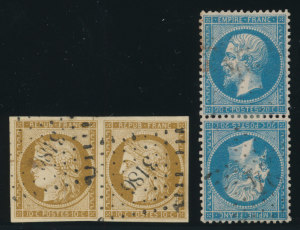France came a bit late to stamps, perhaps because issuing stamps for the prepayment of postage was not a Gallic idea, and so the French were resistant. Still, it was nearly ten years after the success of the Penny Black and the benefits that prepayment of postage conferred before France issued her first stamps in 1849. She was the last major country to do so. French philately has always been among the most popular in the world, and it was the French that even gave the name, philately, to our hobby. Early French dealers and collectors defined how we collect, and French influence on such aspects of our hobby as perforation measurement and shades are felt even today.
French philately has everything that a collector would want. First, the classic stamps of France are beautifully designed and executed. This was no small feat either. For cost reasons, the French printing office produced the first issues of France by typography, not engraving. This process makes producing the printing plates far easier, but because in typography the design is not held in steel, plate wear happens fast. The French printers had to back up the paper they were printing on with additional paper to augment the pressure that was applied to the plate during printing (called decoupage). This is a tiresome task, and it is a tribute to the French printers that there is such consistency on the millions of early French stamps produced by typography. But uneven plate wear was always a problem, and the plates that these early French stamps were produced on were groups of 100 clichés (“cliché” is what each individual stamp die was called) held together in rows. When one cliché was damaged, it could be replaced by itself leaving the stamp cliché around it intact. This produced some of the most stunning varieties in philately, found on many early French stamps and on very few other classic stamps of the world. When the printers replaced a cliché, if the cliché was placed upside down, the result was two stamps that were head to tail next to each other (called “tête-bêche” in French). Not only were tête-bêche stamps unusual—the misplacement of the clichés was unusual in itself and was fixed as soon as it was discovered—but to be collected, a large block had to be saved from just the right part of the sheet or a pair had to be used on a cover.
Beyond all the beautifully engraved twentieth century stamps, the wonderful Semi-postals, Airmails, and specialty items, the tête-bêches of France provide rarity without enormous expense. One of the paradoxes of philately is that countries where the rarities are very expensive have often languished in philatelic popularity, especially in the last thirty years. This is because collectors, seeking an area to collect, aspire to completion, even though that goal is almost never attained. When, as is the case of Switzerland, you have several Cantonals that catalog over $50,000, collectors are impressed, but they gravitate to other areas to collect. France has a few rarities, but of the more than ten thousand collectible varieties of this country, all but fifty can be had for $500 or less, and all but a few hundred for under $25.

